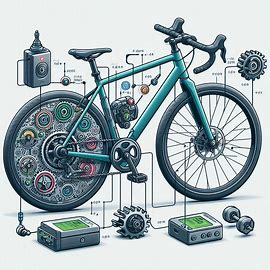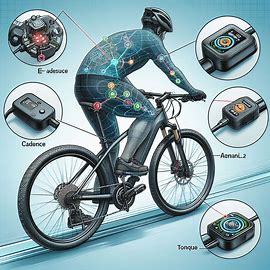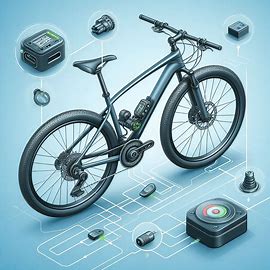How E-Bike Pedal-Assist Systems Work Cadence And Torque Sensors
In recent years, electric bikes, or e-bikes, have surged in popularity as a fun, efficient, and eco-friendly mode of transportation. At the heart of an e-bike’s appeal is its pedal-assist system, which provides a boost to the rider’s pedaling, making it easier to tackle hills, extend rides, and simply enjoy the journey more. But how do these systems work, and what role do sensors play in providing the perfect amount of assistance?
In this post, we’ll explore the mechanics of e-bike pedal-assist systems, focusing on two key components: cadence and torque sensors. Understanding these sensors is essential for anyone considering an e-bike, as they significantly influence the riding experience. Whether you’re a casual rider looking for a leisurely cruise or a fitness enthusiast seeking a more challenging ride, knowing how these systems function can help you choose the right e-bike for your needs.
Section 1: Understanding Pedal-Assist Systems
E-bikes are revolutionizing the way we think about cycling, blending the convenience of motorized travel with the health benefits of traditional biking. Central to the e-bike experience is the pedal-assist system, a technology that seamlessly integrates human power with electric assistance to enhance the rider’s pedaling efforts.
Pedal-assist systems, often referred to as “pedelecs” (pedal electric cycles), are designed to sense the rider’s pedaling and respond with proportional motor assistance. Unlike throttle-based e-bikes, where the rider can engage the motor independently of pedaling, pedal-assist systems require the rider to pedal to activate the motor. This approach ensures that the rider maintains an active role in powering the bike, promoting a more interactive and health-conscious ride.
One of the main advantages of pedal-assist systems is their ability to offer a more natural cycling experience. By providing assistance that matches the rider’s effort, these systems make it easier to climb hills, accelerate from a stop, or simply maintain a comfortable pace without excessive strain. This allows riders to cover greater distances with less fatigue and enjoy their journey more.
Furthermore, pedal-assist systems contribute to improved fitness. Riders can choose the level of assistance that suits their fitness goals or comfort level, gradually reducing reliance on the motor as their strength and endurance improve. This versatility makes pedal-assist e-bikes an excellent choice for commuters, recreational cyclists, and fitness enthusiasts alike.
In summary, pedal-assist systems are a key feature of e-bikes, offering a harmonious blend of human and electric power. By understanding how these systems work, riders can better appreciate the benefits of e-bikes and make informed choices when selecting the right bike for their needs.
Section 2: The Role of Sensors in Pedal-Assist Systems
Sensors are the unsung heroes of e-bike pedal-assist systems, working quietly behind the scenes to ensure a smooth, responsive, and efficient ride. These small but critical components gather data on the rider’s pedaling behavior and translate it into motor assistance, making the cycling experience both intuitive and enjoyable.
At the heart of every pedal-assist system is the ability to detect and respond to the rider’s efforts. Sensors are responsible for this crucial function. By monitoring various aspects of the pedaling process, they enable the e-bike’s motor to provide assistance that matches the rider’s needs in real-time. This seamless integration of effort and assistance is what sets pedal-assist systems apart from other forms of motorized cycling.

The primary role of sensors in these systems is to determine when and how much assistance to provide. There are typically two main types of sensors used in e-bike pedal-assist systems: cadence sensors and torque sensors. Each type of sensor plays a unique role in capturing different aspects of the rider’s pedaling.
Cadence sensors focus on the speed of the pedaling motion, sending signals to the motor when the rider starts pedaling. This results in a steady and consistent level of assistance, ideal for riders who prefer a relaxed cycling experience. Torque sensors, on the other hand, measure the force applied to the pedals. This allows the system to provide a more dynamic response, adjusting the level of assistance based on the rider’s effort, which can be particularly beneficial for those who enjoy a more vigorous ride or need extra power on challenging terrains.
Understanding the role of these sensors is essential for selecting the right e-bike. Whether you prefer the gentle push of a cadence sensor or the more responsive feel of a torque sensor, knowing how these sensors operate will help you make an informed choice that suits your riding style and needs. In the next sections, we’ll dive deeper into the specifics of each sensor type and explore how they contribute to the overall e-bike experience.
Section 3: Cadence Sensors
Cadence sensors are a fundamental component of many e-bike pedal-assist systems, offering a straightforward and reliable method for detecting the rider’s pedaling motion. These sensors measure the rotation speed of the bike’s crank, providing the data necessary for the motor to determine when to assist and how much power to apply.
How Cadence Sensors Work
Cadence sensors operate by detecting the rate at which the pedals are being turned. Typically, they consist of a magnet mounted on the bike’s crank arm and a sensor attached to the frame. As the crank rotates, the magnet passes by the sensor, generating a signal each time it completes a rotation. This signal is sent to the e-bike’s controller, which calculates the pedaling speed and triggers the motor to provide assistance once the pedaling reaches a predetermined threshold.
Types of Cadence Sensors
- Magnet-Based Sensors: The most common type, these sensors use one or more magnets placed on the crank arm to interact with a sensor on the bike frame. The sensor detects the magnetic field changes as the magnets pass by, allowing the system to measure cadence accurately.
- Optical Sensors: These sensors use light beams to detect the movement of reflective materials on the crank. While less common in e-bikes, optical sensors can offer greater precision and durability in harsh conditions.
Advantages of Cadence Sensors
- Simplicity and Cost-Effectiveness: Cadence sensors are relatively simple and inexpensive to produce and install, making them a popular choice in a wide range of e-bikes.
- Smooth Acceleration: By providing consistent motor assistance based on pedaling speed, cadence sensors ensure a smooth and steady acceleration, making for a comfortable riding experience.
Limitations of Cadence Sensors
- Lack of Sensitivity to Pedaling Effort: Cadence sensors measure only the speed of pedaling, not the force applied. This means that the motor’s assistance is not adjusted based on the rider’s effort, which can lead to a less responsive experience compared to systems using torque sensors.
- Delayed Response: In some systems, there can be a slight delay between when the rider starts pedaling and when the motor assistance kicks in, which can be noticeable in certain riding conditions.
Cadence sensors are ideal for riders who prefer a consistent and reliable level of assistance without the need for fine-tuning based on effort. For those looking for a more nuanced riding experience, the addition of torque sensors, which we will explore in the next section, might be a better option.

Section 4: Torque Sensors
Torque sensors bring a more dynamic and intuitive feel to e-bike pedal-assist systems, catering to riders who desire a more natural cycling experience that closely mimics the effort they exert. These sensors measure the force applied to the pedals, allowing the e-bike to respond directly to the rider’s input by adjusting the motor assistance accordingly.
How Torque Sensors Work
Torque sensors are designed to detect the amount of pressure or force a rider applies while pedaling. They are typically integrated into the bike’s bottom bracket, crankset, or rear dropout. As the rider pedals, the torque sensor measures the twisting force or pressure exerted. This data is then transmitted to the bike’s controller, which calculates the appropriate level of motor assistance based on the rider’s effort.
Types of Torque Sensors
- Bottom Bracket Sensors: These sensors are placed in the bottom bracket of the bike and measure the force applied directly through the pedals. They are known for their accuracy and provide a precise measurement of rider effort.
- Crankset Sensors: Integrated into the crankset, these sensors measure the torque applied to the crank arms. They are generally easy to install and maintain.
- Hub Sensors: Located in the hub of the bike’s wheel, these sensors detect torque by measuring the force transmitted through the chain to the rear wheel.
Advantages of Torque Sensors
- Responsive and Intuitive Riding Experience: Torque sensors provide motor assistance that closely matches the rider’s effort, resulting in a more responsive and engaging ride. This makes the e-bike feel more like a traditional bike, with assistance kicking in smoothly and predictably as the rider exerts more force.
- Better Energy Efficiency: By providing assistance proportional to the rider’s effort, torque sensors help optimize battery usage. The motor only delivers the necessary amount of power, conserving energy and potentially extending the range of the e-bike.
Limitations of Torque Sensors
- Higher Cost and Complexity: Torque sensors are generally more expensive and complex to manufacture and install than cadence sensors. This can make e-bikes equipped with torque sensors pricier and potentially more challenging to maintain.
- Sensitivity to Calibration: Torque sensors require precise calibration to function correctly. Improper calibration can lead to inaccurate readings and inconsistent motor assistance.
For riders who seek a more engaging and energy-efficient cycling experience, torque sensors are an excellent choice. By providing assistance that is directly proportional to the effort exerted, these sensors create a more natural and seamless ride. In the next section, we will discuss how combining cadence and torque sensors can offer the best of both worlds.
Section 5: Combining Cadence and Torque Sensors
Combining cadence and torque sensors in an e-bike pedal-assist system can deliver a superior riding experience by leveraging the strengths of both technologies. This hybrid approach provides riders with a more comprehensive and adaptable system that enhances responsiveness, efficiency, and overall ride quality.
The Benefits of a Combined System
- Enhanced Responsiveness: By using both cadence and torque sensors, the system can respond more quickly and accurately to the rider’s needs. Cadence sensors ensure that assistance is activated as soon as the rider starts pedaling, while torque sensors fine-tune the level of assistance based on the rider’s effort. This dual-sensor setup allows for smoother transitions and a more natural feel.
- Optimal Motor Assistance: A combined system ensures that the motor assistance is both consistent and proportional to the rider’s input. Cadence sensors maintain a steady baseline of assistance, while torque sensors adjust the power output in real-time to match the rider’s pedaling force. This results in a more efficient use of energy and a more enjoyable ride.
- Improved Ride Quality: The integration of both sensor types enhances the overall ride quality by providing a balanced and versatile system. Riders can enjoy the ease of use offered by cadence sensors along with the dynamic responsiveness of torque sensors. This combination is particularly beneficial in varied terrains, where the rider’s effort and cadence can change frequently.

Examples of E-Bike Models with Combined Sensors
Many e-bike manufacturers have recognized the advantages of combining cadence and torque sensors and have incorporated this technology into their models. These e-bikes cater to a wide range of riders, from casual commuters to serious cyclists, offering them a tailored riding experience that adjusts to their needs and preferences.
Considerations for Choosing a Combined Sensor System
When considering an e-bike with a combined sensor system, it’s important to take into account several factors:
- Riding Style and Terrain: If you frequently ride in hilly or challenging terrain, a combined sensor system can provide the adaptability and power you need. The torque sensor will ensure you get the right amount of assistance when climbing or navigating difficult paths.
- Budget: E-bikes with combined sensor systems tend to be more expensive than those with single-sensor systems. However, the enhanced performance and efficiency can justify the investment for many riders.
- Personal Preference: Some riders may prefer the simplicity and consistency of a cadence sensor, while others might prioritize the nuanced control of a torque sensor. A combined system offers a middle ground that can satisfy a broad spectrum of preferences.
Combining cadence and torque sensors represents a significant advancement in e-bike technology, providing riders with an optimal blend of power, control, and efficiency. In the next section, we’ll explore how to choose the right sensor system based on your individual needs and preferences.
Section 6: Choosing the Right Sensor System for Your Needs
Selecting the ideal sensor system for your e-bike can greatly enhance your riding experience, ensuring that it aligns with your personal preferences, riding style, and typical terrain. With the variety of sensor configurations available, it’s crucial to consider several key factors to make an informed decision.
1. Riding Style and Terrain
- Casual Commuting and Leisure Rides: If your rides are primarily on flat surfaces or city streets, a cadence sensor system might suffice. These systems provide consistent and smooth assistance that’s ideal for leisurely cycling and urban commuting.
- Challenging Terrains and Fitness Rides: For those who often tackle hills, varied terrains, or want a more rigorous workout, a torque sensor or a combined sensor system is recommended. Torque sensors offer responsive assistance that adapts to your effort, making them perfect for dynamic and changing environments.
2. Budget Considerations
- Cost-Effectiveness: Cadence sensor systems are typically more affordable, making them a good option for budget-conscious buyers or those new to e-bikes who want to test the waters without a large investment.
- Investment in Quality: Torque and combined sensor systems, though more expensive, provide a more refined and efficient riding experience. If you plan to use your e-bike extensively or rely on it for challenging rides, the extra investment might be worthwhile for the enhanced performance and longevity.
3. Personal Preference
- Simplicity vs. Responsiveness: Cadence sensors offer a straightforward and predictable level of assistance, while torque sensors provide a more dynamic and responsive ride. Your choice should reflect your comfort level with technology and your desire for a more interactive riding experience.
- Test Rides: Before making a decision, take advantage of test rides. Trying out different sensor systems can give you a practical feel for how each system performs under various conditions and how it responds to your pedaling style.
4. Maintenance and Durability
- Maintenance Requirements: Consider the maintenance needs of each sensor type. Torque sensors, for instance, may require more regular calibration to maintain accuracy, while cadence sensors are generally low-maintenance.
- Durability: If you plan to use your e-bike in rough conditions or for long periods, opt for a sensor system known for its durability and reliability.
Also Read: How to Choose the Right E-Bike in 2024.
Conclusion
Understanding how e-bike pedal-assist systems work is essential for any rider looking to make the most of their e-bike experience. Whether you’re a casual rider looking for a leisurely commute or a fitness enthusiast aiming for a challenging ride, knowing the differences between cadence and torque sensors can help you choose a system that best fits your needs.
Cadence sensors offer a straightforward and cost-effective solution for riders who prefer consistent assistance and ease of use. Torque sensors, on the other hand, provide a more responsive and intuitive riding experience, adapting to the rider’s effort and ensuring efficient energy use. For those seeking the best of both worlds, a combined system offers a balanced and versatile approach.
By considering your riding style, terrain, budget, and personal preferences, you can select an e-bike that enhances your cycling adventures. As e-bikes continue to grow in popularity, advancements in sensor technology will undoubtedly lead to even more refined and tailored riding experiences.
Whether you’re exploring new terrains, commuting to work, or simply enjoying a ride around your neighborhood, the right pedal-assist system can make all the difference. We encourage you to take the time to test-ride different e-bikes, ask questions, and make an informed choice. Share your experiences or ask any questions in the comments below, and happy riding!